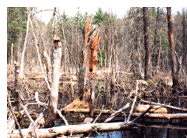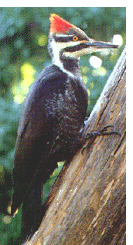A pileated woodpecker was observed by
Pat Mattson on May 6, 2000. The bird was seen  in a "forested wetlands" area which
borders on an "open water" area in the northeastern portion of the
Hackett Hill property. Two wetlands of this type occur in this region
(see Wetlands
Map).
in a "forested wetlands" area which
borders on an "open water" area in the northeastern portion of the
Hackett Hill property. Two wetlands of this type occur in this region
(see Wetlands
Map).
Both wetlands appear to have been created by beaver activity. Millstone Brook splits into two sections as it enters the property and both sections have been damned by beavers. The "forested" portion of the wetlands largely consists of dead trees or tree stumps. Many of these "snags" are riddled with holes of various sizes, apparently made by wood-boring birds searching for insects.
 Woodpeckers have a chisel-shaped
bill, strong zygodactyl feet (usually 2 toes front, and 2 rear) and
stiff spiny tails - special features which enable them to excavate
wood. The bill which is suited for probing for insects and insect
larvae is comprised of strong bone, and is broad at the nostrils to
spread the force of pecking. The feet give the bird an excellent grip
while it is climbing and the tail acts as a prop.
Woodpeckers have a chisel-shaped
bill, strong zygodactyl feet (usually 2 toes front, and 2 rear) and
stiff spiny tails - special features which enable them to excavate
wood. The bill which is suited for probing for insects and insect
larvae is comprised of strong bone, and is broad at the nostrils to
spread the force of pecking. The feet give the bird an excellent grip
while it is climbing and the tail acts as a prop.
The pileated woodpecker is the largest woodpecker. It is a crow-sized bird (16-19 1/2 ") with a flaming red crest, mostly-black body and a horn-colored bill. White bars on its wings are seen only in flight.
Although pileateds eat large amounts of carpenter ants, they also eat insects, beetles, seeds and fruit and are attracted to feeders that provide suet and peanuts.
Pileateds are "cavity nesters". Both sexes participate in the excavation of large oval or oblong nest cavities which are 15-80 feet above the ground. Eggs are deposited on dry chips and male and female take turns incubating the eggs. The birds raise one brood of 3-5 young a year.
Pileateds are non-migratory and
appear to occupy the same territory for a number of years.
Credits: The photograph of the pileated woodpecker appears on the
web site, Backyard
Nature Specialist.
![]() PERTINENT LINK
PERTINENT LINK